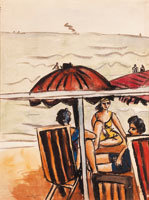Max Beckmann
dal 26/6/2006 al 16/9/2006
Segnalato da
26/6/2006
Max Beckmann
Guggenheim Museum, Bilbao
In a captivating relationship to the paintings, graphic art, and study drawings for compositions, these works in color on paper show the artist experimenting, relaxing, or observing alertly. Alongside the painted oeuvre, one sees an artist who takes his work lightly, who leaves room for humor, who yields to the stimulus of the moment. The exhibition includes nearly one hundred watercolors and pastels from both public and private collections.

Watercolors and Pastels
Max Beckmann (b. 1884, Leipzig, d. 1950, New York) is one of the most important artists of the twentieth century. Appreciation of his oeuvre, however, has only reached its present height since 1980, with retrospectives in New York, Zurich, and Paris kindling an astonishing new interest.
In addition to diverse painted works, including the famous nine triptychs, Beckmann made his name as a graphic artist. In particular, his graphic cycles Berliner Reise (Berlin Journey, 1922) and Die Holle (Hell, 1919) are seen today as essential artistic critiques of the Weimar Republic; the series Day and Dream, produced in America in 1946, sums up as if in a kaleidoscope a world of motifs from almost five decades of creativity.
A few outstanding examples of the watercolors and pastels have been exhibited in surveys of his work, so that works like Odysseus (1933) and Der Raub der Europa (The Rape of Europe, 1933) are as famous as his paintings. Yet an assessment of Beckmann as a “painter on paper" has yet to be undertaken. The works are scattered, often hidden away in private collections, or at least not accessible in concentrated groupings like the paintings [in the St. Louis Art Museum in Missouri or in the Neue Pinakothek in Munich.] Only in the catalogue raisonne' does the importance of his work in these techniques—which are often characterized as light, cheerful, or ephemeral—become clear.
The pastels of the 1920s prepared the way for a new consideration of line and color; the large sheets of 1933 share the radiant color also achieved in the triptych Abfahrt (Departure, 1932-33). In the 1930s and ’40s the watercolors sometimes served as a way to relax from the work on the complex triptychs—for example, the landscapes in Bavaria or on the Baltic Sea.
Nevertheless, the comparatively spontaneous technique of watercolor called for a delight in iconographic experimentation, producing a pictorial inventiveness unusual even for Beckmann, as in Ewichkeit (Eternity, 1936). Following his experiences with the pen drawings for Goethe’s Faust II that Beckmann executed during the war, after 1945 sheets appeared with complex combinations of pen, watercolor, gouache, and charcoal. At the same time, he was also producing spontaneous works that are indebted to immediate visual impressions, like cafe' scenes.
In a captivating relationship to the paintings, graphic art, and study drawings for compositions, these works in color on paper show Beckmann experimenting, relaxing, or observing alertly. Alongside the painted oeuvre, one sees an artist who takes his work lightly, who leaves room for humor, who yields to the stimulus of the moment. Our image of a serious artist who suffered over the problems of history and human existence is expanded to include surprising new aspects. Beckmann’s stupendous technical mastery is particularly striking in the works on paper, but the greatest appeal of these works is that the viewer witnesses a fascinating self-dialogue that is gripping even—or perhaps especially—where it remains enigmatic.
The exhibition, comissioned by Mayen Beckmann and Siegfried Gohr, includes nearly one hundred watercolors and pastels from both public and private collections, and has been organized by the Schirn Kunsthalle Frankfurt and co-produced by the Guggenheim Museum Bilbao.
Guggenheim Museum
Avenida Abandoibarra, 2 - Bilbao
Opening hours: Tuesday to Sunday: 10 a.m.-8 p.m. In July and August the Museum opens Monday to Sunday from 10 a.m. to 8 p.m
Admission: 10.50 eur/ 6.50 eur



